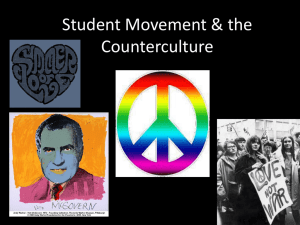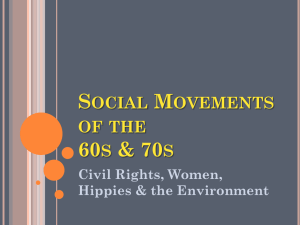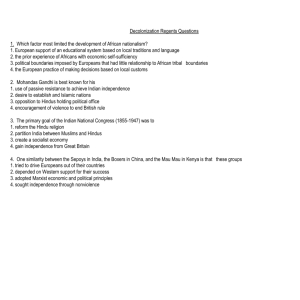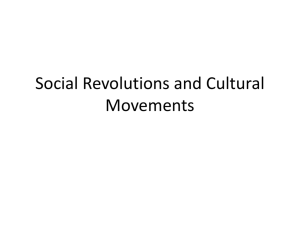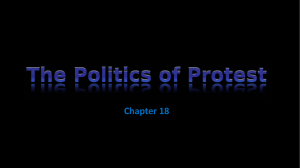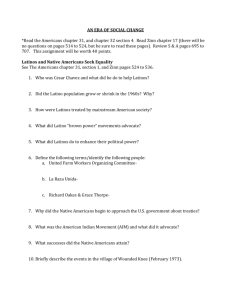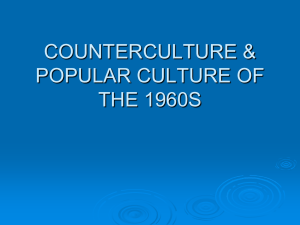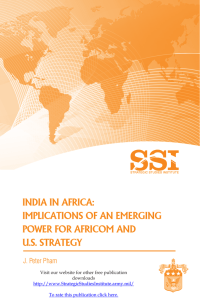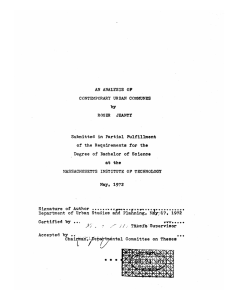The Counterculture & Protest 1960
advertisement
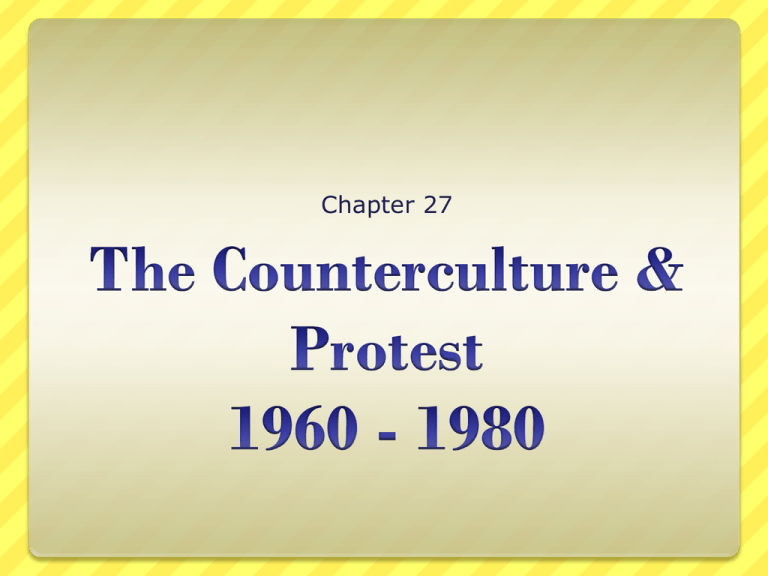
Chapter 27 The Youth Movement Challenged: Political & social system Conventional Middle Class values Inspired by the Beats (of the 1950’s) Originated with “Baby Boomers” By 1970- 58.4% of US 34 years old or younger. 1960-1965- enrollment in 4 year colleges went from 3.1 million to 5 million. * (1959)Students for a Democratic Society (SDS) 1962*Port Huron Statement (Tom Hayden) Anti-Vietnam War Anti-Big Corporation & Big Government Anti-Apathy Also worked against poverty, nuclear power & racism *Mario Savio (leader) UC Berkley limited student publications & recruitment for political causes Dec. 1964- Savio & UC Berkeley students held sit-ins on campus & police arrested 700. Supreme Court said students have a right to free speech and assembly on campus Mostly white middle class Hippies- rejected society Communes Living & working together away from the rest of society *Haight Ashbury District Popular destination for US hippies (San Francisco) New Religion Unification Church Hare Krishna Decline & Impact of the Counterculture After a few years the counterculture declined. Reasons: 1. Hippie communes became dangerous 2. Drug addiction =(death & overdoses) 3. Many hippies got older & moved on Impact of the Counterculture. 1. Fashion- wore cheap surplus clothes from earlier decades, long hair= rejected consumerism 2. Music- made use of folk music & rhythm & blues. 1969-Woodstock (up state NY)- outdoor music festival featured singers Bob Dylan, The Who etc. Art Pop Art Contained elements of popular culture Andy Warhol Pop artist Famous people Music Beatles Bob Dylan Jimi Hendrix All of these created a bigger generation gap between old & young Woodstock Upstate NY August 1969 Festival of music A Renewed Women’s Movement 19th Amendment (1920) granted women the right to vote. Next 40 years, women’s movement had little influence. WWII- women given greater opportunities for work outside home. Post WWII- society emphasized a homemaking role. 1960 –1/3 of married women were part of the paid workforce. Women and the Workplace Newspaper ads separated jobs by gender. Banks denied women credit. Women paid less than men for doing same work. President’s Commission on the Status of Women (Kennedy) 1963- Equal Pay Act passed. Feminism belief that men and women should be equal politically, economically and socially *The Feminine Mystique By *Betty Friedan – best selling book Exposed sense of dissatisfaction women had with the traditional role. Title VII: of the Civil Rights Act of 1964 outlawed job discrimination based on gender National Organization for Women (NOW) Demanded greater educational opportunities (formed by Friedan & others). The Feminist Movement Gloria Steinem: author & public figure - one of the movement’s leading figures (editor—Ms. Magazine). *Title IX: prohibited federally funded schools from discriminating against women 1973- Roe v Wade: ruled that the states could not regulate abortion in the first 3 months of pregnancy because it was a time that would violate the woman’s right to privacy- abortion is legal! Right to Life: anti-abortion movement Equal Rights Amendment: would have protected women against discrimination – it failed (3 states refused to ratify) opposition –Phyllis Schlafly *Affirmative Action: companies doing business with federal government should actively recruit African American employees to improve social and economic status *University of California Regents v Bakke (1978): ruled schools could use racial criteria as part of their admissions process but couldn’t use fixed quotas Swan v Charlotte-Mecklenburg Board of Education (1970) : upheld the constitutionality of busing – transporting minority students to fully integrate schools White Flight: Whites responded by removing their students from public schools African Americans Jesse Jackson: Congressional Black Caucus: political leader People United to Save Humanity (PUSH) worked at registering voters, developing African American businesses and educational opportunities 1971 African American members of Congress organized to more clearly represent the legislative concerns of blacks Hispanic Americans *Cesar Chavez: La Raza Unida (1969): Bilingualism: 1968 Bilingual Education Act: fought for farm workers for increased wages, union recognition and better benefits Created United Farm Workers political party begun in Texas to represent Hispanics teaching in Spanish while also learning English argument - they would be at a competitive disadvantage with English speakers because difficult to understand in another language directed schools to set up classes for immigrants in their own language as they were learning English Declaration of Indian Purpose: Indian Civil Rights Act: American Indian Movement: Indian Self-Determination and Educational Assistance Act: called for policies to create greater economic opportunities on reservations Instead of wanting assimilation they wanted more independence. guaranteed reservation residents the protection of the Bill of Rights a more militant group that made stands at Alcatraz and Wounded Knee in 1970’s. increased funds for Native American education expanded local control in administering federal programs Save the Earth *Rachel Carson- *“Silent Spring”- book about pesticide’s effect on the environment. 1970- Earth Day: Day devoted to addressing nation’s environmental concerns Environmental Protection Agency: created in 1970 by Nixon – set and enforced pollution standards, promoted research and coordinated state activities Clean Air Act: 1970 Nixon established emissions standards for factories and automobiles & ordered industries to comply with standards Clean Water Act: 1972 restricted the discharge of pollutants into the nations’ lakes and rivers Endangered Species Act: 1973 established measures for saving threatened animal species Three Mile Island: March 28, 1979 nuclear facility outside of Harrisburg Pennsylvania overheated after its cooling system failed & low levels of radiation escaped National Traffic and Motor Vehicle Safety Act: Ralph Nader in 1966 regulated the automobile industry for the first time in safety
